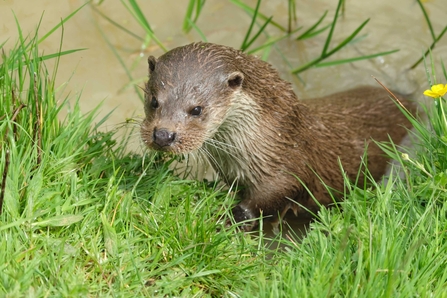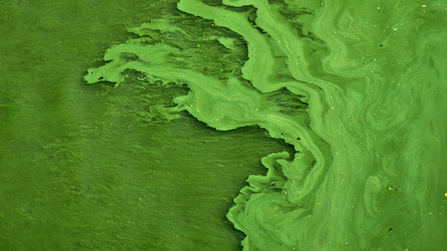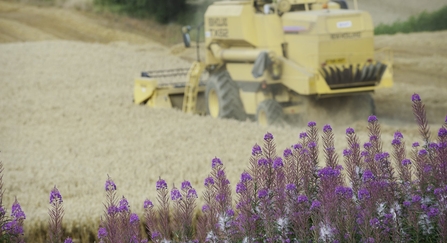Many marvel at the sighting of native freshwater mammals such the European otter (Lutrinae), magnificent bird species like the kingfisher (Alcedinidae), as well as many resident freshwater fish[GB1] . However, there is an specific inconspicuous vital organism that play an important role in the freshwater biome, known as algae. These microorganisms form the base of the entire freshwater food chain and remain the primary producers that aquatic ecosystems depend on.
Looking below the surface…

© Robert Brady
Blue green algae, commonly known as cyanobacteria, is a type of algae frequently found in freshwater biomes. Under certain changes in environmental conditions, this algae will grow and form a harmful algal bloom (HAB); such blooms have previously been sighted at various freshwater sites across Surrey[GB2] . These blooms are often considered a danger to public health, due to the release of toxins that they can produce. In addition, algal blooms can prevent sunlight from reaching underwater plants species and deplete oxygen levels in the freshwater biome through consumption (also known as eutrophication). Subsequently, many aquatic species will likely not survive a HAB.

© Mihály Köles/Unspalsh
An unexpected hero?
As previously mentioned, algae are vital for the survival of other organisms within a freshwater biome - in particular, zooplankton. Zooplankton graze on primarily algae and bacteria, this in turn not only amplifies predator biomass and regenerates nutrients, but also controls algal growth.
Due to their algal grazing, zooplankton are often looked upon to manage algal densities, through a method known as biomanipulation. Biomanipulation methods have historically involved reducing zooplankton predation, with the intent to therefore increase algal grazing. This was achieved either through the direct removal of zooplankton predators, or by adding carnivorous fish species to the environment - such as the northern pike (Escox Lucius). However, such biomanipulation methods are only successful short term and remain unsuccessful as a long-term solution.

How can we prevent HAB’s?
Improving farming practices
By advancing farming practices, we can better soil health that aids in draining rainfall, rather than allowing nutrient dense run-off to wash away into lakes and ponds. This will therefore reduce HABs caused as a result of changes in nutrients within a freshwater biome.

© Paul Harris/2020VISION
Eco-friendly infrastructure
Similar to the water runoff we see from farmland, water run-off from urban landscapes can also contain high nutrient levels. The addition of greenery in urban landscapes will ensure more rain water is absorbed and less run-off into will occur into waterways.
Conservation
Wetlands and other protected areas improve water quality, increase biodiversity and capture nutrient-dense run-off. Therefore, ensuring that we maintain our protected areas through efficient management and policies is vital for reducing HABs.

© Robert Brady
Moving forward
Prevention HAB methods are extremely important in order to protect species biodiversity within our freshwater environments – both for the protection of native species biodiversity, as well as to ensure safe practices for public health. However, we are still a long way from being on top of the HAB crisis. Further research, increased education and improved monitoring are significant steps that need to be taken to ensure we improve our freshwater ecosystems across the globe.
By Grace Brady
Bibliography
Chapman, R.L. (2013). Algae: the world’s most important “plants” – an introduction. Mitigation and Adaptation Strategies for Global Change, pp.5-12.
De Bernardi, R. and Giussani, G. (1990). Are blue-green algae a suitable food for zooplankton? An overview. Hydrobiologia, 200-201(1), pp.29-41.
Denchak, M. and Sturm – Alum, M. (2019). Freshwater Harmful Algal Blooms 101. [Online] Available at: https://www.nrdc.org/stories/freshwater-harmful-algal-blooms-101
Flynn, K. (2008). Attack is not the best form of defence: Lessons from harmful algal bloom dynamics. Harmful Algae, 8(1), pp.129-139.
Haney, J. (1987). Field studies on zooplankton‐cyanobacteria interactions. New Zealand Journal of Marine and Freshwater Research, 21(3), pp.467-475.
Ismael, A.A. (2012). Benthic bloom of cyanobacteria associated with fish mortality in Alexandria waters. The Egyptian Journal of Aquatic Research, 38(4), pp.241-247.
Lampert, W., Fleckner, W., Rai, H. and Taylor, B. (1986). Phytoplankton control by grazing zooplankton: A study on the spring clear-water phase1. Limnology and Oceanography, 31(3), pp.478-490.
Mitra, A. and Flynn, K.J. (2006). Promotion of harmful algal blooms by zooplankton predatory activity. Biology Letters, 2(2), pp.194-197.
Paterson, M. (2019). Zooplankton and Fresh Water: Here are the facts. [Online] Available at: https://www.iisd.org/articles/zooplankton-and-fresh-water (Accessed 15/11/20210).
RMBEL, (2013). The Aquatic Food Web: Who's eating whom? [online] Available at: https://www.rmbel.info/the-aquatic-food-web-whos-eating-whom/ [Accessed 20 Sep. 2019].
Saba, G., Steinberg, D., Bronk, D. and Place, A. (2011). The effects of harmful algal species and food concentration on zooplankton grazer production of dissolved organic matter and inorganic nutrients. Harmful Algae, 10(3), pp.291-303.

